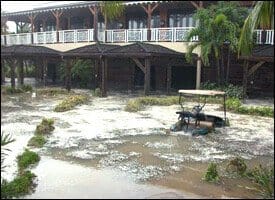
Hurricane Omar Damage To The Four Seasons Resort
2011 Atlantic Hurricane Season Outlook: Summary
NOAA’s 2011 Atlantic Hurricane Season Outlook calls for a 65% chance of an above normal season, a 25% chance of a near-normal season, and a 10% chance of a below-normal season. See NOAA definitions of above-, near-, and below-normal seasons. The Atlantic hurricane region includes the North Atlantic Ocean, the Caribbean Sea, and the Gulf of Mexico.
This outlook reflects an expected set of conditions that is conducive to above-normal Atlantic hurricane activity. These conditions are based on three climate factors:
- The tropical multi-decadal signal, which has contributed to the high-activity era in the Atlantic basin that began in 1995,
- A continuation of above-average sea surface temperatures in the tropical Atlantic Ocean and Caribbean Sea (called the Main Development Region),
- ENSO-neutral conditions most likely (no El Niño or La Niña), with lingering La Niña impacts into the summer.
In addition, several dynamical model forecasts of the number and strength of tropical cyclones generally predict an above normal season.
The conditions expected this year have historically produced some active Atlantic hurricane seasons. Therefore, the 2011 season could see activity comparable to a number of active seasons since 1995. We estimate a 70% probability for each of the following ranges of activity during 2011:
- 12-18 Named Storms,
- 6-10 Hurricanes
- 3-6 Major Hurricanes
- An ACE range of 105%-200% of the 1981-2010 median.
The seasonal activity is expected to fall within these ranges in 7 out of 10 seasons with similar climate conditions and uncertainties to those expected this year. These ranges do not represent the total possible ranges of activity seen in past similar years.
The official NHC seasonal averages are 11 named storms, 6 hurricanes, and 2 major hurricanes.
Hurricane Landfalls:
It only takes one storm hitting your area to cause a disaster, regardless of the overall activity predicted in the seasonal outlook. Therefore, residents, businesses, and government agencies of coastal and near-coastal regions are urged to prepare every hurricane season regardless of this, or any other, seasonal outlook.
While NOAA does not make an official seasonal hurricane landfall outlook, the historical probability for multiple U.S. hurricane strikes, and for multiple hurricane strikes in the region around the Caribbean Sea, increases sharply for exceptionally active (i.e. hyperactive) seasons (ACE > 165% of the median). However, predicting where and when hurricanes will strike is related to daily weather patterns, which are not reliably predictable weeks or months in advance. Therefore, it is currently not possible to reliably predict the number or intensity of landfalling hurricanes at these extended ranges, or whether a given locality will be impacted by a hurricane this season.